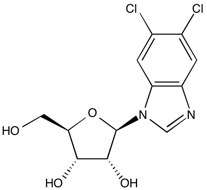DRB | Transcription inhibitor/CK2 inhibitor
NMR (Conforms)

Available Options
| Size: | Price | Quantity | |
|---|---|---|---|
| 10 mM/1 mL DMSO | $35.00 | ||
| 10 mg | $27.00 | ||
| 50 mg | $115.00 |
DRB (53-85-0) is a classic inhibitor of transcription by RNA polymerase II. A relatively selective inhibitor of Cdk9 (IC50=3 μM), the kinase of the positive transcription elongation factor b (P-TEF-b) required for processive transcription elongation by RNA polymerase II.1,2 Also inhibits casein kinase II, IC50=4-10 μM. 3 Suppresses the SIRT1/CK2α pathway and enhances the radiosensitivity of human cancer cells.4 Kinase-independent activities of Cdk9 such as glucocorticoid receptor modulation are not inhibited by DRB.5
References/Citations:
1) Baumli et al. (2010), Halogen bonds form the basis for selective P-TEFb inhibition by DRB; Chem. Biol., 17 931
2) Yamaguchi et al. (1998), Interplay between positive and negative elongation factors: drawing a new view of DRB; Genes Cells, 3 9
3) Zandomeni (1989), Kinetics of inhibition by 5,6-dichloro-1-beta-D-ribofuranosylbenzimidazole; Biochem.J., 262 469
4) Wang et al. (2014), Inhibition of P-TEFb by DRB suppresses SIRT1/CK2α pathway and enhances radiosensitivity of human cancer cells; Anticancer Res., 34 6981
5) Zhu et al. (2014), A kinase-independent activity of Cdk9 modulates glucocorticoid receptor-mediated gene induction; Biochemistry, 53 1753
NMR (Conforms)
Safety Data Sheet:
Product Data Sheet:
Materials provided by Focus Biomolecules are for laboratory research use only and are not intended for human or veterinary applications. Please note that we do not sell to individuals and that all orders placed by non-research organizations will incur a $20 restocking/refund fee
DRB (53-85-0) is a classic inhibitor of transcription by RNA polymerase II. A relatively selective inhibitor of Cdk9 (IC50=3 μM), the kinase of the positive transcription elongation factor b (P-TEF-b) required for processive transcription elongation by RNA polymerase II.1,2 Also inhibits casein kinase II, IC50=4-10 μM. 3 Suppresses the SIRT1/CK2α pathway and enhances the radiosensitivity of human cancer cells.4 Kinase-independent activities of Cdk9 such as glucocorticoid receptor modulation are not inhibited by DRB.5
References/Citations:
1) Baumli et al. (2010), Halogen bonds form the basis for selective P-TEFb inhibition by DRB; Chem. Biol., 17 931
2) Yamaguchi et al. (1998), Interplay between positive and negative elongation factors: drawing a new view of DRB; Genes Cells, 3 9
3) Zandomeni (1989), Kinetics of inhibition by 5,6-dichloro-1-beta-D-ribofuranosylbenzimidazole; Biochem.J., 262 469
4) Wang et al. (2014), Inhibition of P-TEFb by DRB suppresses SIRT1/CK2α pathway and enhances radiosensitivity of human cancer cells; Anticancer Res., 34 6981
5) Zhu et al. (2014), A kinase-independent activity of Cdk9 modulates glucocorticoid receptor-mediated gene induction; Biochemistry, 53 1753
Calculate the molar concentration, mass or volume in a solution.
Concentration × Volume × Molecular Weight = Mass
Focus Biomolecules • Plymouth Meeting, PA USA • 1-855-FOCUS21
Focus Biomolecules
Plymouth Meeting, PA USA
1-855-FOCUS21
Website Created by Advanta Advertising LLC.

